 | Frank Frazetta. Egyptian Queen Painting, Original Art (1969). Frank Frazetta would continue to produce paintings for another 30 years, but this unforgettable image captured the hearts of legions and remains burned into the minds of generations. The Egyptian Queen first appeared in print as the cover for Eerie magazine #23 in mid-1969, and countless prints and posters were produced over subsequent decades. This masterpiece has resided with the Frazetta family since its creation, it is the first time it has ever been offered on the market. It made $5.4m on 16th May, 2019.  |
Monday, July 15, 2019
Frank Frazetta - Egyptian Queen - $5.4m
Tuesday, July 9, 2019
Ancients at Heritage's Platinum Night
 IONIA. Ephesus. Phanes (ca. 625-600 BC). EL stater. NGC VF 4/5 - 4/5. | Heritage's selection of coins from across the ancient world is staggering. Leader is the impossibly rare Phanes stater. Phanes coinage falls into seven denominations, from the stater down to a 1/96 stater, all featuring the stag in various poses. |  |
 SICILY. Syracuse. Time of Dionysius I (405-367 BC) AR decadrachm NGC MS 5/5 - 5/5. | Considered to be the most beautiful coins ever struck, the silver decadrachms of Syracuse represent the apex of classical Greek sculptural art. Syracuse, the foremost Greek city in Sicily, had produced coins of great beauty for a century when engravers began signing their coin dies. Master engravers Kimon and Euainetos are recognized today. | 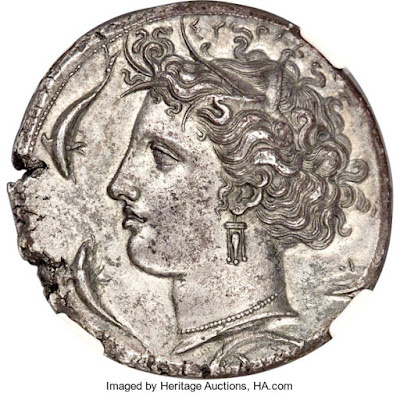 |
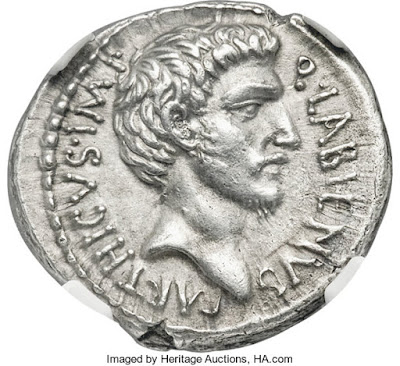 Quintus Labienus, rebel Imperator (40-39 BC). AR denarius. NGC AU 5/5 - 3/5 | Quintus Labienus was the son of Titus Labienus, one of Julius Caesar's generals, who threw his support to Pompey and the Senate during the Civil War of 49-45 BC. Following the assassination of Caesar in 44 BC, Quintus fell in with the assassins Brutus and Cassius. He would be toppled by the end of the year, 40BC. |  |
Sunday, July 7, 2019
Furies - the Erinyes
 | The Furies were the three goddesses of vengeance: Tisiphone (avenger of murder), Megaera (the jealous) and Alecto (constant anger). They were also called the Daughters of the Night, but were actually the daughters of Uranus and Gaea. Another name for them is the Erinyes. The Erinyes live in Erebus and are more ancient than any of the Olympians. Their task is to hear complaints brought by mortals against the insolence of the young to the aged, of children to parents, of hosts to guests, and of householders or city councils to suppliants—and to punish such crimes by hounding culprits relentlessly. The Erinyes are crones and often described as having snakes for hair, dog's heads, coal black bodies, bat's wings, and blood-shot eyes. Their victims die in torment. |
 | A victim seeking justice could call down the curse of the Erinys upon the criminal. The Roman Furies were originally nothing but a personification of curses pronounced upon a guilty criminal. |  |
Saturday, July 6, 2019
The Pereshchepina Treasure
 Belt Plaque Gold. Late 7th century BC | The Pereshchepina Treasure is a major deposit of Bulgarian, Sassanian, Sogdian, Turkic and Avarian objects. The hoard was discovered in 1912 in the village of Mala Pereshchepina (20 km from Poltava, Ukraine) by a boy shepherd who literally stumbled over a golden vessel and fell into what is thought to be the grave of Kuvrat, the founder of Great Bulgaria and father of Asparuh, the founder of the First Bulgarian Empire. |  |
 Comb with Scythians in Battle. Gold; cast and chased. Late 5th - early 4th century BC |  Plaque in the Form of the Head Gold; stamped.Scythian. 4th century BC | 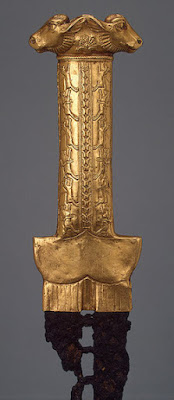 Sword Hilt. Gold and iron; chased. Scythian. 5th century BC |
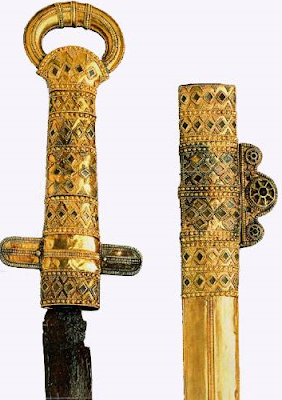 | The 800 piece trove contains finely crafted gold artifacts that exceeds 21 kg and 50 kg of silver. (42 pounds, 110 pounds) Items ranged from 500 BC to 670 AD and are objects of Byzantine, Persian and Barbarian origin. Three gold rings are engraved with the monogram of Kubrat, and his 400gm gold patrician buckle and sword were found.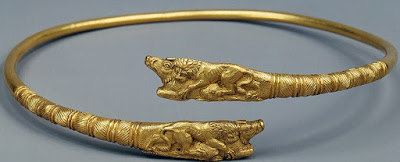 |  |
 Necklace. Gold; stamped, soldered, filigreed, repousse. Meotian Culture. Late 4th century BC | 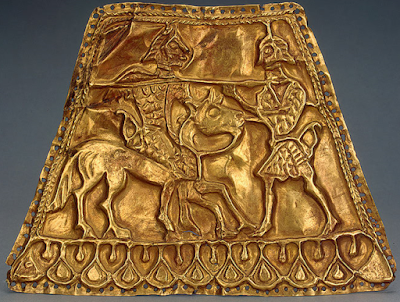 Plaque with Scythian Warriors. Gold; repousse. Scythian. 4th century BC |  Facing for a Horse's Frontlet Gold; stamped. Scythian. 4th century BC |
 Overlay for a Goryt (Case for a Bow and Arrows) Gold; stamped. Scythian. 4th century BC  Hand-Washing Vessel: Pitcher and Ladle Poltava Region, Ukraine. Silver gilt |  Overlay for a Wooden Vessel Gold; stamped. Scythian. First half of the 5th century BC  Pair of Boat-Shaped Earrings Gold; forged, stamped, soldered, filigreed. Scythian. 4th century BC |  Goblet Poltava Region, Ukraine 7th century  |
Tuesday, July 2, 2019
Tipu Sultan - the Tiger of Mysore
 | Tipu Sultan (20 November 1750 – 4 May 1799), also known as the Tiger of Mysore, was the Indian ruler who resisted the East India Company’s conquest of southern India. Opinion in England considered him a vicious tyrant, while modern Indian nationalists hail him as a freedom fighter. |  In the Fourth Anglo-Mysore War, the combined forces of the British East India Company and the Nizam of Hyderabad defeated Tipu, and he was killed on 4 May 1799 while defending his fort of Srirangapatna. |
 Tipu's Tiger, c.1790. Made for the amusement of Sultan Tipu; the tiger has a miniature organ with keyboard and bellows to simulate the groans of a dying British officer. | 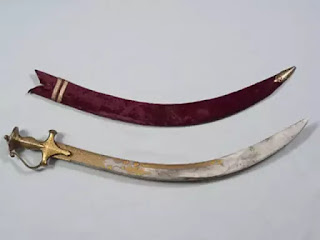 Inscribed Sword of Tipu Sultan. Former liquor magnate Vijay Mallya bought the sword in 2004 but gave it away 9 years later saying it brought him bad luck. | 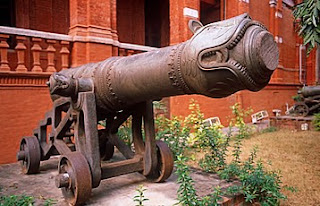 Cannon used by Tipu Sultan at Srirangapatna in 1799 |
 |  |  |
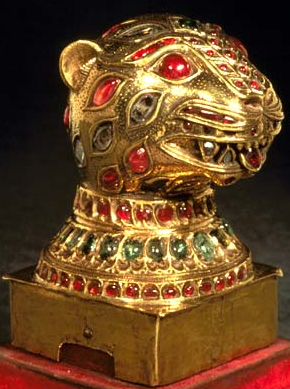 A gem-encrusted gold tiger finial from the throne of Tipu Sultan sold for £434,400. | Tipu Sultan ruled a vast swathe of southern India during the 18th century. He fought ferociously against the encroachments of the British East India Company, but was ultimately defeated.  | 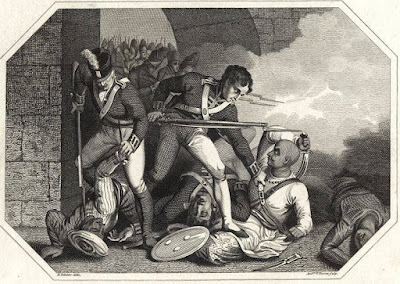 'In this world I would rather live two days like a tiger, than two hundred years like a sheep.' - Tipu Sultan |
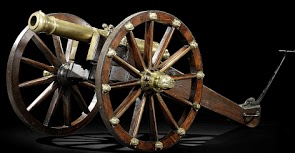 | A 3-pounder bronze cannon sold for £1.4m ($2.1m). A flintlock pistol with left-hand lock, made for Tipu Sultan at Seringapatam, dated AD 1797-98. |  |
 Inscription on the barrel reads: 'The peerless rifle of the Khusraw of India to which the forked lightning in second can seal the enemy's fate if his forehead is made the target.' | A two shot superimposed-load silver-mounted flintlock from the armoury of Tipu Sultan, dated AD 1793-94. A pair of silver-mounted Flintlock pistols with left and right-hand locks, made for Tipu Sultan, dated AD 1794-95. Sold For: £134,500 |  |
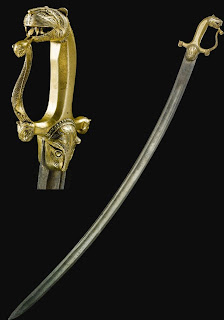 |  A Tipu Sultan sword fitted with a captured English blade. |  |
Subscribe to:
Comments (Atom)





